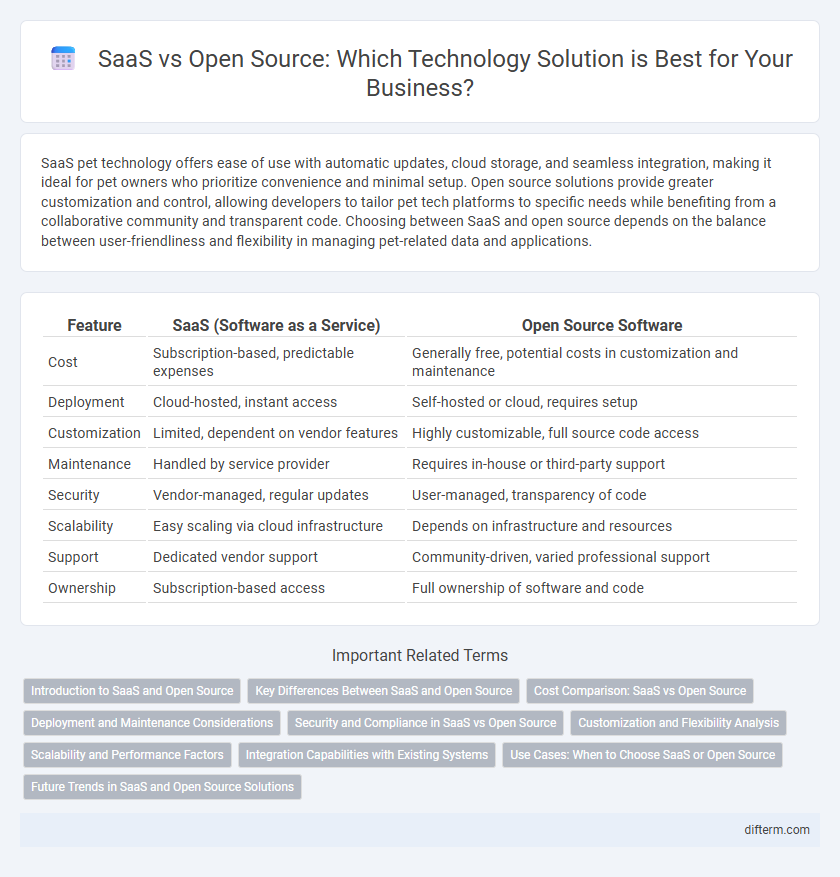SaaS pet technology offers ease of use with automatic updates, cloud storage, and seamless integration, making it ideal for pet owners who prioritize convenience and minimal setup. Open source solutions provide greater customization and control, allowing developers to tailor pet tech platforms to specific needs while benefiting from a collaborative community and transparent code. Choosing between SaaS and open source depends on the balance between user-friendliness and flexibility in managing pet-related data and applications.
Table of Comparison
| Feature | SaaS (Software as a Service) | Open Source Software |
|---|---|---|
| Cost | Subscription-based, predictable expenses | Generally free, potential costs in customization and maintenance |
| Deployment | Cloud-hosted, instant access | Self-hosted or cloud, requires setup |
| Customization | Limited, dependent on vendor features | Highly customizable, full source code access |
| Maintenance | Handled by service provider | Requires in-house or third-party support |
| Security | Vendor-managed, regular updates | User-managed, transparency of code |
| Scalability | Easy scaling via cloud infrastructure | Depends on infrastructure and resources |
| Support | Dedicated vendor support | Community-driven, varied professional support |
| Ownership | Subscription-based access | Full ownership of software and code |
Introduction to SaaS and Open Source
Software as a Service (SaaS) delivers cloud-based applications accessible via the internet, enabling businesses to use software without local installation or maintenance. Open Source software provides freely available source code that developers can inspect, modify, and enhance, fostering collaboration and customization. These models contrast in deployment, control, and cost structures, shaping technology strategies across industries.
Key Differences Between SaaS and Open Source
SaaS offers subscription-based access to software hosted on cloud servers, eliminating the need for local installation and ongoing maintenance, while Open Source requires self-hosting and provides access to source code for full customization. SaaS typically delivers automatic updates, customer support, and scalability managed by providers, whereas Open Source relies on community support and user-driven maintenance. Security models differ as SaaS vendors handle data protection centrally, whereas Open Source security depends on user implementation and transparency of the codebase.
Cost Comparison: SaaS vs Open Source
SaaS platforms typically involve predictable subscription fees that cover maintenance, updates, and support, making budgeting straightforward but often resulting in higher long-term costs. Open source software eliminates licensing fees, offering initial cost savings, but may incur significant expenses related to implementation, customization, and ongoing technical support. Evaluating total cost of ownership between SaaS and open source requires careful consideration of deployment complexity, required IT expertise, and scalability needs.
Deployment and Maintenance Considerations
SaaS platforms offer streamlined deployment with automatic updates and managed infrastructure, reducing the burden on internal IT teams. Open Source solutions require manual setup and ongoing maintenance, demanding dedicated resources for updates, security patches, and scaling. The choice hinges on balancing control and customization against ease of use and operational efficiency.
Security and Compliance in SaaS vs Open Source
SaaS platforms typically offer robust security features and compliance certifications such as SOC 2, HIPAA, and GDPR, ensuring ongoing regulatory adherence managed by dedicated teams. Open source software provides transparency and flexibility for custom security implementations but requires organizations to independently handle updates, patches, and compliance auditing. Choosing between SaaS and open source depends on the balance between control, resource investment, and the need for standardized security frameworks.
Customization and Flexibility Analysis
SaaS platforms offer limited customization options confined to predefined settings, enabling quick deployment but restricting tailored workflows and integrations. Open source software provides extensive flexibility, allowing developers to modify source code and create bespoke features that precisely align with specific business needs. This depth of customization in open source solutions supports complex, evolving requirements, making it ideal for organizations prioritizing full control and adaptability.
Scalability and Performance Factors
SaaS platforms deliver scalable infrastructure managed by providers, enabling seamless resource allocation during traffic spikes without user intervention. Open source solutions offer customizable scalability, reliant on in-house expertise to optimize performance and infrastructure scaling. Performance in SaaS benefits from dedicated cloud environments and automatic updates, whereas open source demands manual tuning to achieve comparable responsiveness and reliability.
Integration Capabilities with Existing Systems
SaaS platforms offer seamless integration capabilities through pre-built connectors and APIs, enabling rapid deployment with minimal IT overhead. Open source solutions provide greater customization flexibility, allowing businesses to tailor integrations deeply with existing legacy systems. Choosing between SaaS and open source depends on the need for quick integration versus extensive system adaptability and control.
Use Cases: When to Choose SaaS or Open Source
SaaS solutions excel in scenarios requiring rapid deployment, minimal IT maintenance, and scalability, making them ideal for businesses prioritizing operational efficiency and cloud integration. Open Source platforms offer greater customization, control, and cost-saving potential, suited for organizations with in-house technical expertise and specific security or compliance needs. Choosing between SaaS and Open Source hinges on factors like budget constraints, desired flexibility, implementation speed, and long-term maintenance capabilities.
Future Trends in SaaS and Open Source Solutions
Future trends in SaaS emphasize enhanced AI integration and automated workflows to boost efficiency and user experience. Open source solutions are rapidly evolving with increased community collaboration and customizable security frameworks that support flexible innovation. Hybrid models combining SaaS scalability with open source transparency are predicted to dominate enterprise technology strategies.
SaaS vs Open Source Infographic

 difterm.com
difterm.com